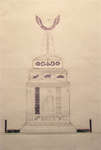"Archeologists' Version of History Strays From The Facts"
- Publication
- Brantford Expositor, Spring 1990
- Full Text
- Archeologists' version of history strays from the facts
OHSWEKEN - Last week I happened to run into Rick Sanderson, one of the teachers at J.C. Hill School in Ohsweken. He gave me an article from a magazine which he thought would interest me. He was right.
It was about the issue of what should be done when farmers and builders turn up the skeletal remains of people from ancient native cemeteries. At one time all sorts of indignities were heaped on them, such as being put on public display. Now the remains of native people receive a measure of protection. Since 1978 archeologists here in Ontario have been following a provincial protocol.
When Indian remains are dug up, whoever owns the land must negotiate with the nearest native band as to whether to leave the bones in place, to rebury them somewhere else, or to store them for a later decision.
Most Indian leaders now demand reburial as soon as possible. This does not sit well with some archeologists and physical anthropologists. Scientists often seem to think they know what's best for everyone.
In the article, from the University of Western Ontario's Alumni Gazette, the white academics raised several objections. One of the arguments is that modern Indian bands have very little blood relationship with ancient natives for whose bones they have responsibility. Michael Spence, an archeologist in the anthropology department at UWO, claimed that there was no blood link between the Oneida, who now live near London, and the prehistoric Neutral people whose bones are found there. This statement is wrong, as I will show.
He further claimed that the Neutrals died out around 1650 at the hands of the Oneida and other Six Nations people who conquered southern Ontario at that time. This is standard Canadian textbook history which combines one wrong statement with one correct statement.
Mr. Spence kept putting his foot in it by saying that the Oneida and Neutrals had very different burial and other cultural practices. He then made the astounding claim the the Oneida "were responsible for putting them in the ground in the first place." I can only hope that he knows more about his chosen field than about Six Nations history.
It is a well-known fact that the Neutral nations, the Petun (Tobacco) nations and the Huron (Wyandot) Confederacy who occupied southern Ontario were all Iroquoian-speaking people. The Huron language is very similar to Mohawk and Oneida and, in fact, they share some of the same words.
The culture was almost identical among all Iroquoians. They all lived in Longhouse villages and were farmers who grew such vegetables as corn, beans and squash. They even shared the same religion. We, on the Six Nations reserve, know this because remnants of Tutelo Indian ceremonies are still alive today in the rituals of the Longhouse religion. Some of the elders can even tell you which families still carry the blood of this Neutral Indian nation. Some of the Nanticokes, another Neutral nation, were also adopted by one of the Six Nations. I don't know why he thinks that their cultural practices were different. Maybe he read that in some other white man's book.
As for who was responsible for their demise, it was European diseases for which they had no immunity. My own nation, the Tuscaroras, was almost wiped out. Even a casual reading of native history will turn up many cases of villages that had a 100 per cent mortality rate. Not one baby was left breathing. The New World natives lost about 17 million people, according to studies by the Berkeley Group.
After they were decimated by disease the Hurons, Petuns (Pay-toons) and Neutrals were invaded by the Six Nations but they were not "put into the ground" by them as Mr. Spence so delicately put it. Some who chose not to fight were adopted as mentioned before and hundreds simply moved out of the disputed area. The Six Nations were invading to stop the fur trade from flowing down the waterways to the French in Quebec. By their invasion they diverted the furs through their territory to the British. They were not trying to simply put others "under the ground."
Most Hurons today are called Wyandots. Some old books call them Wendats (woan-dots). There are Wyandots in Michigan, Wisconsin and as far south as Oklahoma. I met two last week from Huron Village in Quebec. They are making contact with other Iroquoian people to revitalize their native culture.
Our Town is an Expositor feature which provides a forum for news and views from some of the smaller centres in the region. George Beaver, a Six Nations reserve resident, was a teacher and principal on the Six Nations and New Credit reserves for 33 years.
- Creator
- Beaver, George, Author
- Media Type
- Newspaper
- Item Types
- Articles
- Clippings
- Description
- "Last week I happened to run into Rick Sanderson, one of the teachers at J. C. Hill School in Ohsweken. He gave me an article from a magazine which he thought would interest me. He was right."
- Date of Original
- Spring 1990
- Subject(s)
- Personal Name(s)
- Sanderson, Rick ; Spence, Michael.
- Corporate Name(s)
- J. C. Hill ; University of Western Ontario.
- Local identifier
- SNPL002760v00d
- Collection
- Scrapbook #2
- Language of Item
- English
- Creative Commons licence
 [more details]
[more details]- Copyright Statement
- Public domain: Copyright has expired according to Canadian law. No restrictions on use.
- Copyright Date
- 1990
- Copyright Holder
- Brantford Expositor
- Contact
- Six Nations Public LibraryEmail:info@snpl.ca
Website:
Agency street/mail address:1679 Chiefswood Rd
PO Box 149
Ohsweken, ON N0A 1M0
519-445-2954



